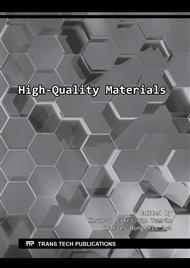[1]
C. Shi, P.V. Krivenko, D. Roy, Alkali-activated cements and concretes, In Abingdon, (2006).
DOI: 10.4324/9780203390672
Google Scholar
[2]
J. He, Y. Jie, J. Zhang, Y. Yu, G. Zhang, Synthesis and characterization of red mud and rice husk ash-based geopolymer composites, Cem. Concr. Compos. 37(1) (2013) 108–118.
DOI: 10.1016/j.cemconcomp.2012.11.010
Google Scholar
[3]
A.M. Rashad, A brief on high-volume Class F fly ash as cement replacement: A guide for civil engineer, Int. J. Sustain. Built Environ. 90 (2015) 1–29.
DOI: 10.1016/j.ijsbe.2015.10.002
Google Scholar
[4]
F.A. Memon, M.F. Nuruddin, S. Demie, N. Shafiq, Effect of curing conditions on strength of fly ash based self-compacting geopolymer concrete, Int. J. Civil, Environ. Struct. Constr. Archt. Eng. 5(8) (2011) 8–22.
DOI: 10.4028/www.scientific.net/amm.567.362
Google Scholar
[5]
American Concrete Institute (ACI), ACI manual of concrete pratice index (2015).
Google Scholar
[6]
J.L. Provis, Geopolymers and other alkali activated materials: why, how, and what? Mat. Struc. 47(1–2) (2014) 11–25.
DOI: 10.1617/s11527-013-0211-5
Google Scholar
[7]
G. Görhan, G. Kürklü, The influence of the NaOH solution on the properties of the fly ash-based geopolymer mortar cured at different temperatures, Compos. B. Eng. 58 (2014) 371–377.
DOI: 10.1016/j.compositesb.2013.10.082
Google Scholar
[8]
H. Zhu, Z. Zhang, Y. Zhu, L. Tian, Durability of alkali-activated fly ash concrete: chloride penetration in pastes and mortars, Constr. Build. Mater. 65 (2014) 51–59.
DOI: 10.1016/j.conbuildmat.2014.04.110
Google Scholar
[9]
M. Criado, A. Fernández-Jiménez, A. Palomo, Alkali activation of fly ash: Effect of the SiO2/Na2O ratio. Part I: FTIR study, Micropor. Mesopor. Mat. 106(1–3) (2007) 180–191.
DOI: 10.1016/j.micromeso.2007.02.055
Google Scholar
[10]
I. Ismail, S.A. Bernal, J.L. Provis, R. San Nicolas, S. Hamdan, J.S.L. van Deventer, Modification of phase evolution in alkali-activated blast furnace slag by the incorporation of fly ash, Cem. Concr. Compos. 45 (2014) 125–135.
DOI: 10.1016/j.cemconcomp.2013.09.006
Google Scholar
[11]
W. Zhou, C. Yan, P. Duan, Y. Liu, Z. Zhang, X. Qiu, D. Li, A comparative study of high- and low-Al2O3 fly ash based-geopolymers: the role of mix proportion factors and curing temperature, Mater. Des. 95 (2016) 63–74.
DOI: 10.1016/j.matdes.2016.01.084
Google Scholar
[12]
M.J.A. Mijarsh, M.A.A. Johari, Z.A. Ahmad, Compressive strength of treated palm oil fuel ash based geopolymer mortar containing calcium hydroxide, aluminum hydroxide and silica fume as mineral additives, Cem. Concr. Compos. 60 (2015) 65–81.
DOI: 10.1016/j.cemconcomp.2015.02.007
Google Scholar
[13]
A. Fernández-Jiménez, A. Palomo, Composition and microstructure of alkali activated fly ash binder: Effect of the activator, Cement. Concrete. Res. 35(10) (2005) 1984–(1992).
DOI: 10.1016/j.cemconres.2005.03.003
Google Scholar
[14]
W.K. Part, M. Ramli, C.B. Cheah, An overview on the influence of various factors on the properties of geopolymer concrete derived from industrial by-products, Constr. Build. Mater. 77 (2015) 370–395.
DOI: 10.1016/j.conbuildmat.2014.12.065
Google Scholar
[15]
C. Hwang, T. Huynh, Effect of alkali-activator and rice husk ash content on strength development of fly ash and residual rice husk ash-based geopolymers, Constr. Build. Mater. 101 (2015) 1–9.
DOI: 10.1016/j.conbuildmat.2015.10.025
Google Scholar
[16]
E. Smidt, K. Böhm, M. Schwanninger, The application of FT-IR spectroscopy in waste management, in: G. Nikolic, (Ed.), Fourier transforms-new analytical approaches and FTIR strategies, InTech, Rijeka, Croatia. 2011, p.405–430.
DOI: 10.5772/15998
Google Scholar
[17]
Y. Liu, W. Zhu, E. Yang, Alkali-activated ground granulated blast-furnace slag incorporating incinerator fly ash as a potential binder, Constr. Build. Mater. 112 (2016) 1005–1012.
DOI: 10.1016/j.conbuildmat.2016.02.153
Google Scholar
[18]
M. Zhang, T. El-Korchi, G. Zhang, J. Liang, M. Tao, Synthesis factors affecting mechanical properties, microstructure, and chemical composition of red mud-fly ash based geopolymers, Fuel 134 (2014) 315–325.
DOI: 10.1016/j.fuel.2014.05.058
Google Scholar
[19]
K. Somna, C. Jaturapitakkul, P. Kajitvichyanukul, P. Chindaprasirt, NaOH-activated ground fly ash geopolymer cured at ambient temperature, Fuel 90(6) (2011) 2118–2124.
DOI: 10.1016/j.fuel.2011.01.018
Google Scholar
[20]
A.M.M.A. Bakri, H. Kamarudin, M. Bnhussain, A.R. Rafiza, Y. Zarina, Effect of Na2SiO3/NaOH ratios and NaOH molarities on compressive strength of fly-ash-based geopolymer. ACI Mater. J. 109(5) (2012) 503–508.
DOI: 10.14359/51684080
Google Scholar
[21]
C. Montes, E.N. Allouche, Influence of activator solution formulation on fresh and hardened properties of low-calcium fly ash geopolymer concrete, CCGP 4 (2012) 1–9.
DOI: 10.4177/ccgp-d-10-00017.1
Google Scholar
[22]
K. Wang, S.P. Shah, A. Mishulovich, Effects of curing temperature and NaOH addition on hydration and strength development of clinker-free CKD-fly ash binders, Cement. Concrete. Res. 34(2) (2014) 299–309.
DOI: 10.1016/j.cemconres.2003.08.003
Google Scholar
[23]
A.N. Reddy, D. Anitha, U.V. Tilak, Performance of alkali activated slag and alkali activated slag + fly ash with various alkali activators, Int. J. Eng. Res. Tecnol. Res. 2(1) (2014) 73–78.
DOI: 10.1201/9781003082460-5
Google Scholar
[24]
I. Ismail, S.A. Bernal, J.L. Provis, R. San, D.G. Brice, A.R. Kilcullen, S. Hamdan, J.S.J. Deventer, Influence of fly ash on the water and chloride permeability of alkali-activated slag mortars and concretes, Constr. Build. Mater. 48 (2013) 1187–1201.
DOI: 10.1016/j.conbuildmat.2013.07.106
Google Scholar
[25]
N. Chousidis, E. Rakanta, I. Ioannou, G. Batis, Mechanical properties and durability performance of reinforced concrete containing fly ash, Constr. Build. Mater. 101 (2015) 810–817.
DOI: 10.1016/j.conbuildmat.2015.10.127
Google Scholar
[26]
M. Kawamura, K. Takeuchi, A. Sugiyama, Mechanisms of expansion of mortars containing reactive aggregate in NaCl solution, Cement. Concrete. Res. 24(4) (1994) 621–632.
DOI: 10.1016/0008-8846(94)90186-4
Google Scholar
[27]
P.W. Brown, A. Doerr, Chemical changes in concrete due to the ingress of aggressive species, Cement. Concrete. Res. 30(3) (2000) 411–418.
DOI: 10.1016/s0008-8846(99)00266-5
Google Scholar
[28]
P. Feng, C. Miao, J.W. Bullard, A model of phase stability, microstructure and properties during leaching of portland cement binders, Cem. Concr. Compos. 49 (2014) 9–19.
DOI: 10.1016/j.cemconcomp.2014.01.006
Google Scholar


